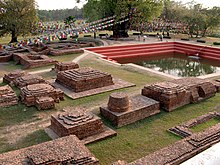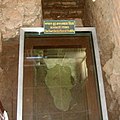Lumbini - The birth place of Lord Gautam Buddha
 |
|
| UNESCO World Heritage Site | |
|---|---|
| Location | Rupandehi District, Nepal |
| Coordinates | 27°28′53″N 83°16′33″E |
| Criteria | Cultural: (iii), (vi) |
| Reference | 666 |
| Inscription | 1997 (21st Session) |
| Lumbini लुम्बिनी |
|
|---|---|
| City era | |

Lumbini
|
|
| Coordinates: 27.484°N 83.276°ECoordinates: 27.484°N 83.276°E | |
| Country | Nepal |
| Zone | Lumbini |
| District | Rupandehi |
| Elevation | 150 m (490 ft) |
| Languages | |
| • Official | Nepali |
| Time zone | NST (UTC+05:45) |
| Postal Code | 32914 |
| Area code(s) | 71 |
Maya devi Temple
The ancient Mayadevi Temple, Lumbini, Nepal.
Lumbini was made a World Heritage Site status by UNESCO in 1997.[1][2]
Contents
In Buddha's time
Location of Lumbini, Nepal
The Sutta Nipáta (vs. 683) states that the Buddha was born in a village of the Sákyans in the Lumbineyya Janapada. The Buddha stayed in Lumbinívana during his visit to Devadaha and there preached the Devadaha Sutta.[13]
Rediscovery
| Pilgrimage to |
| Buddha's Holy Sites |
|---|
 |
| The Four Main Sites |
| Four Additional Sites |
| Other Sites |
| Later Sites |
Eternal Peace Flame
Recent excavations beneath existing brick structures at the Mayadevi Temple at Lumbini have uncovered evidence for an older timber structure beneath the walls of the newer brick Buddhist shrine, which was constructed during the Ashokan era. The layout of the Ashokan shrine closely follows that of the earlier timber structure, which suggests a continuity of worship at the site. The pre-Mauryan timber structure appears to be an ancient bodhigara (tree shrine), consisting of postholes and a wooden railing surrounding a clay floor containing mineralized tree roots that appears to have been worn smooth by visitors. Radiocarbon dating of charcoal from the wooden postholes and optically stimulated luminescence dating of elements in the soil suggests human activity (possibly pre-Buddhist tree worship) began at the site around 1000 BCE, followed by the development of a Buddhist monastery-like community by approximately 550 BCE.[14]
Present-day
Lumbini
The holy site of Lumbini has ruins of ancient monasteries, a sacred Bodhi tree, an ancient bathing pond, the Ashokan pillar and the Mayadevi Temple, where the supposed place of birth of Buddha is located. From early morning to early evening, pilgrims from various countries perform chanting and meditation at the site.
A non-governmental organization named Samriddhi Foundation started in 2013 working extensively in the field of education and health specially in government schools of the area where underprivileged children study. A non-governmental organisation called "Asia Pacific Exchange and Cooperation Foundation" (APECF) backed by chairman of the Unified Communist Party of Nepal (Maoist) and then Prime Minister Prachanda, the Chinese government and a UN group called "United Nations Industrial Development Organization" (UNIDO) signed a deal to develop Lumbini into a "special development zone" with funds worth $3 billion.[15] The venture was a China-UN joint project. A broader 'Lumbini Development National Director Committee' under the leadership of Pushpa Kamal Dahal was formed on 17 October 2011.[16] The six-member committee included Communist Party of Nepal (Unified Marxist-Leninist) leader Mangal Siddhi Manandhar, Nepali Congress leader Minendra Rijal, Forest Minister Mohammad Wakil Musalman, among other leaders. The committee was given the authority to "draft a master plan to develop Lumbini as a peaceful and tourism area and table the proposal" and the responsibility to gather international support for the same.[16]
Nipponzan Myohoji decided to build a Peace Pagoda in the park in 2001, which is visited by many different cultures and religions every day.
Because some Hindus regard the Buddha as an incarnation of Vishnu, thousands of Hindus have begun to come here on pilgrimage during the full moon of the Nepali month of Baisakh (April–May) to worship Queen Mayadevi as Rupa Devi, the mother goddess of Lumbini.
Lumbini was granted World Heritage status by UNESCO in 1997.[1][2]
On the Nepali rupee
Nepal's central bank has introduced a 100-rupee Nepali note featuring Lumbini, the birthplace of Buddha. The Nepal Rastra Bank said the new note would be accessible only during the Dashain, Nepal's major festival in October 2013. It displays the portrait of Mayadevi, Gautam Buddha's mother in silver metallic on the front. The note also has a black dot which would help the blind recognise the note. The name of the central bank in Latin script would be printed on the note along with the date of printing in both the Christian Era and the Bikram Era. The new note is being issued following a cabinet decision 27 August.[17]Transport
Lumbini is a 5-hour drive from Kathmandu and a 30-minute drive from Bhairahawa. The closest airport is Gautam Buddha Airport at Bhairahawa, with flights to and from Kathmandu.[18]The India border town Sonauli is 1 hour drive from Lumbini and Gorakhpur railway station in India is 4 hours drive from Lumbini.
Foreign visitors (2012–2014)
| Year | Jan | Feb | Mar | Apr | May | Jun | Jul | Aug | Sept | Oct | Nov | Dec | Total |
|---|---|---|---|---|---|---|---|---|---|---|---|---|---|
| 2014 | 8,356 | 17,964 | 20,037 | 6,843 | 2,553 | 2,111 | 2,726 | 14,123 | 7,999 | 16,433 | 21,089 | 12,765 | 132,926[19] |
| 2013 | 9,371 | 17,869 | 22,581 | 7,101 | 3,654 | 3,552 | 3,621 | 9,685 | 7,351 | 13,610 | 16,483 | 10,618 | 125,496[20] |
| 2012 | 6,591 | 20,045 | 20,519 | 8,295 | 1,316 | 1,366 | 2,651 | 17,924 | 7,955 | 13,099 | 21,740 | 14,566 | 136,067[20] |
Gallery
See also
References
Bibliography
- Weise, Kai; et al. (2013), The Sacred Garden of Lumbini – Perceptions of Buddha's Birthplace (PDF), Paris: UNESCO, archived from the original (PDF) on 2014-08-30
























0 comments:
Post a Comment